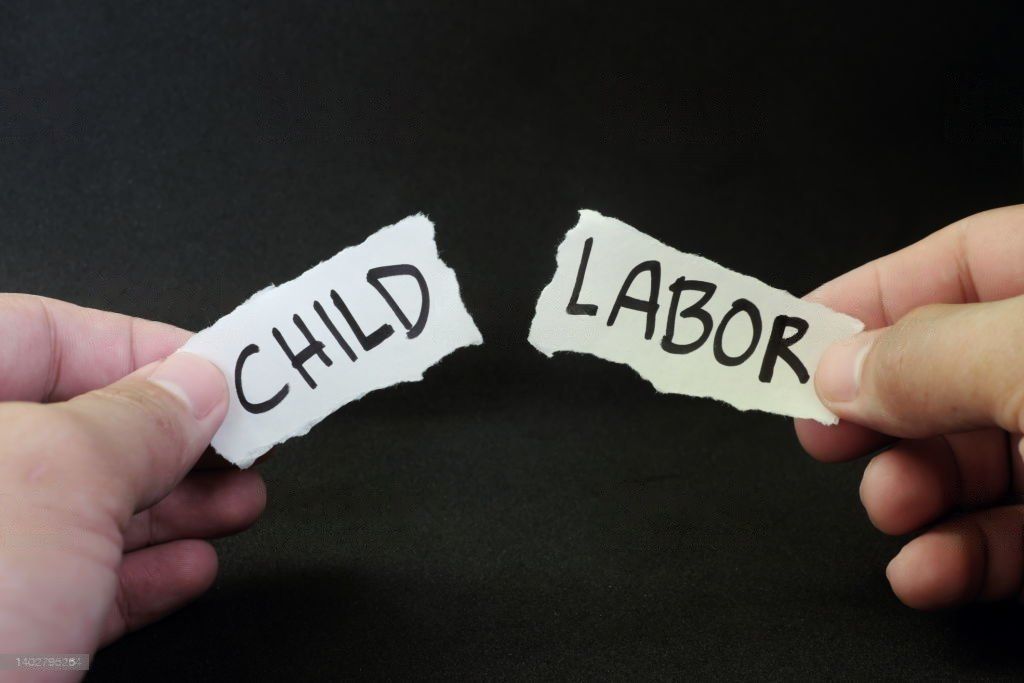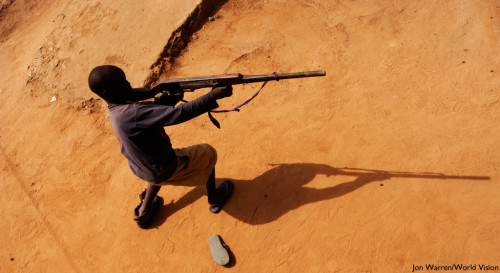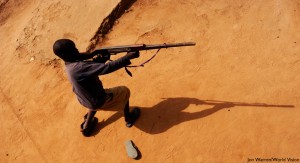As the rattle of gunfire echoed loudly outside, Mohamed Abdi sat in the corner of a Mogadishu restaurant and wondered aloud how much longer he could survive in one of the world’s most dangerous capitals. “Mogadishu is full of miseries, sometimes you fall into traps and can be abducted by either government forces or insurgents, to fight for their cause.”
The 15-year-old’s father died two years ago and since then life in Somalia has been a daily struggle to support his mother and two brothers who live in a nearby refugee camp. Unlike thousands of his countrymen who have been displaced because of fighting between government forces and Al Shabaab -a militant Islamist group linked to Al Qaeda- Abdi is fortunate in that he recently found work as a waiter. However, it was not so long ago that the youth was fighting in urban warfare.
As Somalia’s civil conflict continues unabated, child soldiering is an issue of growing concern. In a report last month Amnesty International (AI) detailed cases of children as young as nine years being made to take fight in war. The report – In The Line of
Fire: Somalia’s Children Under Attack – exposed the full impact of the on-going conflict on children and said that both Somalia’s Transitional Federal Government and Al Shabaab were guilty of gross human rights violations.
“Somalia is not only a humanitarian crisis: it is a human rights crisis and a children’s crisis,” said Michelle Kagari, Amnesty International’s Deputy Director for Africa. “As a child in Somalia, you risk death all the time: you can be killed, recruited and sent to the frontline, punished by Al-Shabaab because you are caught listening to music or ‘wearing the wrong clothes’, be forced to fend for yourself because you have lost your parents or even die because you don’t have access to adequate medical care.”
Abdi rarely leaves his workplace, or ventures onto Mogadishu’s streets, mainly out of fear he might be abducted again by his former captors. It was not long after his father died in 2009 that he was taken by Al Shabaab. He was initially accused of spying for the government and then driven from Mogadishu to a training centre in Marka about 60 miles from the capital. After military training he was moved back to Mogadishu.
“Children do tasks such as spying for the insurgents or the government, it depends on which side they are working with, and they also assemble explosives. I fought in Industrial Street in Mogadishu. While on the frontline one night, I was on guard at our base in Shirkole. It was dark and two of my colleagues on duty fell asleep so I managed to escape,” explained Abdi whose family moved to Mogadishu four years ago from the Bay and Bakol regions of the south Somalia.
The teenager now washes plates and earns 60,000 Somali shillings, the equivalent to US$ 2 per day. He considers himself extremely fortunate as reports from lower Shabelle, Hiram, Middle Shabelle and the lower Jubba regions of Somalia – strongholds of Al-Shabaab- indicate the forced recruitment of children drastically increased after insurgents withdrew from the capital this month to allow aid agencies into the benighted city.
“Children were forcibly dragged from their homes for recruitment even though some of the children were not able to hold a gun,” said Ali Mohamed, a father in the port town of Kismayo whose son is missing, believed to have been taken by Al-Shabaab.
The effect of war has been nothing short of catastrophic and AI said children are also being denied access to education and that many had been killed or injured in indiscriminate attacks carried out in densely populated areas. Education has suffered because school buildings have been destroyed or damaged during fighting in urban areas. In Mogadishu, many schools have closed down as children and teachers fear being killed or injured on their way to school.
“During the 21 years of the military rule ousted in 1991, education was free and orphanage centres were scattered around the country and children were given special care,” said Abdisalam Hared, a secondary school teacher in Mogadishu.
Like many of his peers, Hared is increasingly concerned about the influence radical Islamists hold over children. He said some of his pupils told him he must dress like a Muslim and not wear jeans. Mohamed Abdirahman, another high school teacher, said some pupils have been involved in fighting and have links with the insurgents while others told him their Amirs (group leaders) were calling for them to join the fighting.
“We let them go. Some of them did not come back and were reportedly killed in the frontlines,” Abdirahman added.
Many innocent youngsters have been killed during fighting, including three friends of Abdifatah Hassan, a high school student in Mogadishu. They were killed in a mortar attack in which two others were wounded. He said: “Sometimes we are out of schools for months when fighting intensifies in the capital and residents flee in their residential areas, students go with their parents and schools are almost empty.”
In the areas of Mogadishu controlled by Islamists, Al-Shabaab has imposed strict rules and ordered that students should enlist in the fight against the government. The insurgents have banned non-Arabic signs on shops and ordered businesses in the Elasha settlement on the outskirts of the capital to remove English and Somali posters and replace them with billboards in Arabic.
“Even children under the age of thirteen were joined (sic) in the list, we couldn’t stop this and parents often blame on us,” said Ali Mohamed Herzi, principal of an intermediate school at the Elasha settlement which is under Al-Shabaab control.
Al Shabaab is supposed to have left Mogadishu but its fighters are still launching attacks from their city strongholds and their strategy is based on Afghan style hit and run tactics designed for urban warfare. “We are present in the capital and our fighters are here ready to launch the second phase of our war against the infidels and their collaborators,” said Shaekh Ali Mohamoud , a spokesman for Al-Shabaab.
In northern parts of the city – including Deynile, Huriwaa and Suukha Hoolaha where government forces did not fully advance – remnants of Al-Shabaab and their sympathisers launch regular assaults to show their presence. Over the last two weeks more than ten people – including a women and three children aged between 13 to 15 years old – were beheaded in Huriwaa , Suukha Hoolaha and Huriwa districts for allegedly spying for the government, said Omer Ja’fan Abdulle, commissioner of Huriwaa.
Elsewhere, life is dire for hundreds of orphaned children left destitute. UNICEF said at least 2000 children are trying to survive as on the streets of Mogadishu. “We are aware of the difficulties and hardships they are facing” said Shepherd-Johnson, spokesman for UNICEF in Somalia. Aside from the fighting, Somalia is suffering the worst drought and famine in 60 years and nearly two million children under the age of five are currently in need of humanitarian assistance in the Horn of Africa, Unicef added.






